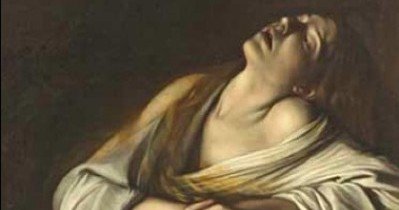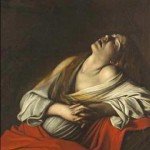Reverberations of Realism: “Caravaggismo” in 17th-,18th- and 19th-century art
From 1600 until the present, Caravaggio’s work has influenced many trends in art, including that of Cezanne. Caravaggio’s breakthrough was his sharp realism: Saints shown as average people and religious experiences as ordinary human drama – expressed through emotions, theatre and allegory. He depicted idealized concepts as manifested in the visible world. Though an extraordinary colorist, he was selective in his compositions – each detail of his paintings corresponds to reality and the models he used.
Caravaggio affected many artists, both his contemporaries and those who followed. His direct influence can be traced in Guido Reni, Giovanni Lanfranco and Mattia Preti. An affinity for his style is seen in the works of Josep de Ribera and Georges du Mesnil de La Tour, who also painted tavern scenes with card players, musicians and fortune-tellers. Mythical and revered figures are replaced by toothless hags, young women of dubious moral character, rough soldiers in scenes more profane than sacred.
Even Pieter Paul Rubens showed a kind of dedication and attention towards the Baroque realist. He observed the realism of Caravaggio’s paintings and at times followed his lead, especially when in his decisive use color and light (both direct and diffused) and in a sense of drama placed in certain wise and studious scenes. Rubens’ triumphant, exuberant scenes bathed in light, in which the physical and the glorious overlap, produce a dynamic tension that
Caravaggio would have appreciated. Later artists, such as Jacopo Cerutti studied this technique with great attention. Known as Pitocchetto, he omitted beautiful nature “a priori,” which was typical of his time, to explore humanity and its inherent morality. It must be noted here how chiarascuro and grace, Caravaggio’s trademarks, were also indispensible in the theories of Raffaello Mengs, even if not applied in his artwork.
Among the 19th-century artists that can be linked to Caravaggio, one in particular stands out for his use of realism: Gustave Courbet.
Both artists also used ordinary people as models for their paintings, those who represented the everyday, actual world, which both studied with curiosity. They captured the psychological aspect of those who sat for their portraits. Before Courbet, there was Jacques-Louis David who avidly studied Caravaggio during his residence in Rome in 1775, during which time he made a copy of the Cena di Valentin. And the Caravaggio-esque influence in David is rediscovered in several of his painted narratives, as in his Death of Marat, which shows a classically-styled, highly-illuminated model depicted in a way that makes the scene palpably realistic. In a remarkably personal manner and with his own brilliant treatment, Géricault manifested Caravaggio-esque passion in his works, especially in his fresh approach to spirituality in smoothly-rendered paintings.
The impressionists cannot be left out. Light, the protagonist in the works of Caravaggio, was fundamental to this group of 19thcentury artists. The difference is that Caravaggio played with light inside his studio, while the Impressionists worked in the open daylight, studying the effects of natural light on their subjects.
About the Author
A graduate of Art History, art critic Genny Di Bert is Professor of Modern Art for RUFA Academy in Rome. She has been lecturer on “The Phenomenology of Contemorary Art” and “Art History” for the Accademia Brera of Milan, Accademia Belle Arti of Palermo, NABA of Milan and Catholic University of Milan. She is curator of the Eleutheria Art Foundation in Prague. In Italy, she is Tribunal expert on Modern Art and a member of the National Association of Journalists. She has authored several non-fiction books and has published several articles about art, costume and society. She is also columnist in Progetto Repubblica Ceca and Il Domani d’Italia. She collaborates with museums, galleries, publishing houses and international institutions. Among the exhibitions she has curated: The New Europe in Biennal of Venice 1995, Unimplosive Art in Biennal of Venice 1997 and many initiatives within the European Mediterranean Cultural Exchanges. Most recently, she has collaborated with Vittorio Sgarbi for the Biennale of Venice 2011 and for all Special Art Events for Italian Pavillon, in occasion of the Century Italy’s Unity.




